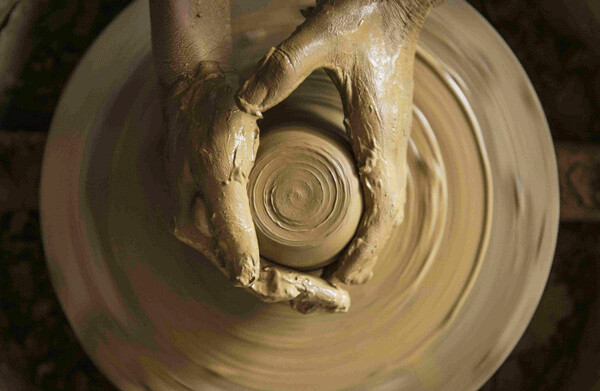News & Articles
Browse all content by date.

I know I’m not the first to look down the long strings and cords of the past and wondered just how some things began. For readers on the Range and in the Ports mining and shipping are at one end of a production system resulting in economical and useful metal. Iron and shipping are less the local giants than was once so, but these things were clearly major parts in regional development. Said this way the story begins to sound boring and too scholarly. You’re possibly eager for me to get on with it or at least get to the part of the tale where pot comes in.
For that, I’m afraid, we have to look much further back and far away. Be relieved I have no intention of covering glacial history or the much older formation of iron. As I see the trail we don’t get anywhere near iron metallurgy for a long, long time. There is evidence of ancient use of meteoric iron, and in some parts of the world early people figured out how to use bog iron. If we look to our own experiences I’ll bet almost none of us has ever seen a meteorite much less found one of useable size. Chance or sporadic finds are not enough to support the technological skills to make iron or steel. I think the beginning is early and simple. That’s why I say we owe a lot to pots.
The first step as I see it has to be in the near universal human practice of making pots. Unglazed pottery is one of the most common and durable things a society leaves behind. Organic material burns, rots, and doesn’t leave much evidence. In contrast, which explains why so many people all over the planet made it, compared to its’ organic counterparts pottery is uniquely useful and highly durable. The step from making a pot to metallurgy is, however, a long stride indeed. We have a record of prehistoric regional pottery. Visiting a local museum or repository can show you a history of regional pottery covering around a thousand years. Making earth wares was useful to survival. Of the types made in our region some were plain, others decorated, with variations in thickness and shape that archaeologists use to categorize them. This kind of pot making is seasonal (not a February activity) and depends on some local source of suitable clay. Selecting and working clay is more involved than I’ve time for here. Making pottery is a complicated skill to master. But all the types found in our regional past as well as all other basic pottery has an important thing in common. It isn’t kiln fired.
The step to kiln building to make pottery needs more population and some specialization among people. As populations and societies grew the demand for good pots grew with it. At that point the activity is beyond that of an individual artisan seasonally producing pots for self and kin. A supply of useful clay has to be met with a source of fuel. If the pot producer has to travel to a clay source and then go further and further to find fuel there is less time for firing pottery. Pots made in kilns tell us something about population size and development.
The pottery kiln sets a basis for what can eventually become a metal smelting furnace. Human experience with use of high heat had to begin somewhere and grow to a size where this skill is shared by enough people to feed further development. I think we can credit our industry to much earlier progress in pottery production. This didn’t happen quickly. Many, many thousands of Roman amphora mass produced in an early industrial process doesn’t mean a jump forward to iron making. A lot had to happen along the way, but development of the kiln/furnace was an essential step. It’s most likely that copper and glass were the first furnace productions. An insight into the process of development is the tradition of glassblowers referring to molten glass as metal. Kiln/furnace use gave the experience needed to deal with higher temperatures. Copper, gold, silver, tin, and lead were sometimes found in near pure deposits. Excellent copper was found on Isle Royale and northern Michigan, but without a background in kilns leading to metal working furnaces this resource was apparently never carried beyond heat treating of copper at a few area sites. Stepping up to bronze needed access to tin. One reason Rome was interested in Britain was the supply of Cornish tin. Cornish mining has a long history and goes to more recent mines in Michigan and Minnesota that imported the skills of Cornish miners who brought with them the pasty we know today. (Rather decent pasties are made daily in Biwabik.) You see, I hope, the story twists and weaves along many lines and routes that pass through many people before getting to industrial metallurgy we see today.
The role and success of the Iron Range, the Twin Ports, and the eastern steel industry began in the workaday making of basic pottery. The route included the difficult and dangerous reduction of ores having noxious byproducts. Start with developing the talents needed to fire a local clay in an open bonfire. If you visit a local archive you can appreciate the skills that went into making earth wares known as Laurel and Selkirk. Prehistoric potters were very capable. Would you or I know what clay to use, how to prepare it, and what else needed to be done before it could be fired to make pottery? Mastery of basic pottery done from scratch is no small thing, but many more generations of effort and experience was needed to build up a metallurgical culture. The same general pattern is seen in China where amazing kilns and furnaces were developed to produce fine porcelain and huge ornate metal castings. That too, on the other side of the planet from us, began with people making useful earth wares in open fires.
For those who hold formal English a classist waste of time I’ve left out one word, one letter, in the title to show small distinctions matter.
| Tweet |


